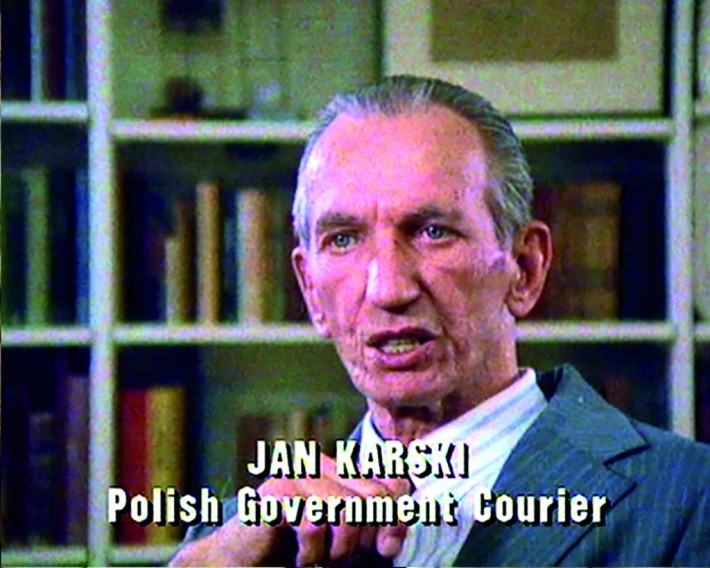Using, losing, resurrecting ‘A Different World’
Messages from Poland: Using, losing and resurrecting ‘A Different World’
In 1987 Channel 4 broadcast the nine-part documentary series, The Struggles for Poland. One of its parts, A Different World, is now available on DVD. Martin Smith, its producer, describes the long process in getting it to home video.
 About the author: Martin Smith has been making and writing documentary films for British and American television for more than thirty years. His awards include an EMMY, several BAFTA nominations, two George Peabody Awards, an ‘Outstanding Archival Achievement’ prize from the British Film Institute, a Royal Television Society Award, and numerous Film Festival successes. His work has been the subject of two special screenings (1998, 2000) at the Sheffield International Documentary Film Festival, a BBC educational film, and a Hungarian television documentary. A pioneer in narrative museum exhibitions, his work as Exhibition Director at the United States Holocaust Memorial Museum, Washington, D.C., resulted in an Award for Design Excellence from President William Clinton. In January and April 2010 his nine-hour series ‘The Struggles for Poland’ was the subject of two complete retrospective screenings at London’s Imperial War Museum. In May 2010, his film about one of Britain’s worst coal-mining disasters ‘The Terrible Price – Gresford 1934’ was one of the opening attractions at the British Film Institute’s Mediatheque in Wrexham.
About the author: Martin Smith has been making and writing documentary films for British and American television for more than thirty years. His awards include an EMMY, several BAFTA nominations, two George Peabody Awards, an ‘Outstanding Archival Achievement’ prize from the British Film Institute, a Royal Television Society Award, and numerous Film Festival successes. His work has been the subject of two special screenings (1998, 2000) at the Sheffield International Documentary Film Festival, a BBC educational film, and a Hungarian television documentary. A pioneer in narrative museum exhibitions, his work as Exhibition Director at the United States Holocaust Memorial Museum, Washington, D.C., resulted in an Award for Design Excellence from President William Clinton. In January and April 2010 his nine-hour series ‘The Struggles for Poland’ was the subject of two complete retrospective screenings at London’s Imperial War Museum. In May 2010, his film about one of Britain’s worst coal-mining disasters ‘The Terrible Price – Gresford 1934’ was one of the opening attractions at the British Film Institute’s Mediatheque in Wrexham.
His personal website can be found at: www.aboutmartinsmith.co.uk
As I began writing this (1 October 2013), the BBC’s news website had a headline: ‘Holocaust historian Israel Gutman dies in Jerusalem’. I am saddened. Professor Gutman, wounded fighting the Germans in the 1943 Warsaw Jewish Ghetto uprising, has often been in my thoughts these past two years. He’s in my computer alongside film images of Jewish life in Poland.
[Israel Gutman, film interview]: These were the days that the Germans went from house to house and they burned the buildings and blew them up. And the fire, the heat penetrated the bunkers that were underground and poisoned everything – ruined the water, ruined the food. [Cut to a still of the Warsaw ghetto uprising.] There wasn’t any air. The air was boiling and people were living in a true hell, a true hell.
Filmed in 1985 by Raye Farr, with whom I had worked on The World at War, the interview is part of a nine-part documentary series The Struggles for Poland. The international co-production was transmitted in 1987 by Britain’s Channel 4, America’s PBS station WNET and Germany’s Norddeutscher Rundfunk. In addition to decent ratings, its successes included a British Film Institute award for ‘Outstanding Archival Achievement’, a book by Neal Ascherson and a Polish film season at Britain’s National Film Theatre.
However, the series drew insults and anger from a section of Britain’s Polish community. The first three films chronicle the rebirth of the Polish nation from 1919 until the Second World War. These, and especially the third, A Different World, provoked a heated correspondence in Britain’s Polish language daily newspaper Dziennik Polski. As Neal Ascherson reported in Index for Censorship (January 1988): ‘The letters culminated in a call for the establishment of a British-based ‘Committee for the Defence of the Good Name of the Motherland’ which would vet applications by ‘foreign’ media or scholars to study Polish archives … A few complainers suggested that the entire series had been deliberately financed by Jewish money, in order to damage the reputation of Poland.’
Some letters came directly to me: one anonymously informed me that the Polish community knew that my name was really Cohen: another, with a name and address, bluntly asked: ‘Who signed the cheques?’ ‘I did,’ was my reply as I pointed out that the money came from the broadcasters.
After the series completed its British run, Slowo Ojezyste (a periodical of the Polish Education Society) carried a commentary by its editor, Jerzy Samborski, in which he declared: ‘Polish history has never been presented on the international stage in such detailed, comprehensive and, at the same time, modern and attractive form … It is difficult to imagine a better way of popularising the Polish issue than showing The Struggles for Poland.’ The response to Samborski’s article by the Association of Polish Combatants was to ban the distribution of all Slowo Ojezyste copies containing Samborksi’s review. More importantly for the series, the controversy led to the withdrawal of an offer by a Polish-born British entrepreneur to finance the release of the series on VHS.

In the meantime, Jeshajahu Weinberg, Museum Director of the United States Holocaust Memorial Museum in Washington D.C., asked me to consider becoming the Director of the Museum’s permanent exhibition. So I signed a two-year contract and left for Washington where, together with Weinberg, I chose the renowned New York designer Ralph Appelbaum to join me in bringing the permanent exhibition to life. The Museum opened its doors in April 1993, its long-term success exceeding the founders’ dreams. More than thirty-five million people have visited the permanent exhibition, and their comments are overwhelmingly positive.
What is not obvious, unless you look for it, is how much the exhibition’s method and style is rooted in the tradition of British documentary filmmaking. (One dramatic encounter, Ralph Appelbaum’s ‘Tower of Faces’, is the direct result of a sequence in A Different World.) The emphasis on the experiences of ‘ordinary people’, its segments, pacing, text and precise use of imagery and objects can be traced back to the forty-year old example set by Jeremy Isaacs with The World at War. That series is still on TV and is easily available in various formats. The Struggles for Poland is not. It has not been nationally repeated and was never available on VHS or DVD. A failure? Perhaps, but I haven’t been able to shake off the conviction that it’s a television history worth preserving, not just for Poles and Jews, but for anyone seriously interested in politics, genocide and the Holocaust.

Some fifteen years ago, The Struggles for Poland was marked down by its sales agent as, ‘obsolete.’ It was necessary because there’s an occasional archive shot or sequence that has a user license that lasted only ten years. Renewing such licenses is a time-consuming and expensive undertaking. Getting a new lease of life for the series on television, or for DVD release, seemed unachievable. It’s not like writing a book.
Yet since the series was transmitted, the Holocaust and genocide have found a place in Britain’s national curriculum and become a matter of educational concern across the world. I now see the Holocaust as a way of recognising that genocide has been and is a recurring feature of human behaviour. It’s a message every generation needs to hear.
I was musing about such things two years ago with Ralph Appelbaum. No, I’ll rephrase that. I was moaning that I couldn’t find any educational trust or sponsor willing to fund the clearances and technical costs of releasing even one film on DVD. A few weeks later I had the grant needed to make A Different World available in the twenty-first century.
… all I had to do, I thought, was to check the archive clearances, locate the master tapes, press a button and roll out the DVDs. It wasn’t like that.
I imagined a painless exercise. I was the copyright owner of the films and had retained the non-theatrical rights. All I had to do, I thought, was to check the archive clearances, locate the master tapes, press a button and roll out the DVDs. It wasn’t like that. Limited companies had come and gone, contracts were missing, the surviving tapes were of poor quality, and my estimate of the license renewal costs looked woefully inadequate. How incompetent I felt without a production manager to guide me through the post-production maze. How silly not to appreciate the tangles involved in making subtitles in three languages, creating DVD chapters, finding a distributor, and writing a booklet to accompany every disc.
Month after month I pressed on and slowly things took shape. Less than two minutes of archive film required new licenses. The licensing costs alone for making a maximum of 5,000 DVDs – cleared internationally for home and educational use – was a hefty £4,678. Initial quotes were cheaper but excluded educational rights; I had no option and paid up. Given the disappointing picture quality of the ‘master’ tapes, I had the entire film re-mastered and the images took on a new life.

I had used up half the grant money when the twenty-five year old contracts I’d signed turned up and revealed that while I was the holder of the copyright and non-theatrical licenses, any exploitation of those rights had first to be agreed with the original broadcasters. I was in a spin. I hadn’t cleared the arrangements with broadcasters in advance – supposing they didn’t agree? In my plans, there would be an initial run of 1,000 DVDs. I wasn’t engaged in a commercial operation, and any receipts from sales, other than distribution fees, would be annually donated to Holocaust educational charities. I nervously approached Channel 4, WNET and NDR and explained the situation. I offered to provide annual financial and distribution reports and on that basis the DVD release went ahead.
In 1985, as part of a pilot programme for the original series, I had filmed an interview with Jan Karski, the Polish Roman Catholic courier who brought back reports from Nazi-occupied Poland to the West. The interview was so powerful and revealing it became a separate film, Messenger from Poland, and was transmitted as a spin-off programme. Last year President Obama posthumously awarded Jan Karski America’s highest civilian honour, the Presidential Medal of Freedom. It has made Karski a more widely known hero to Roman Catholics and Jews alike. 2014 is the one hundredth anniversary of his birth, in Poland it will be celebrated as Karski Year 2014. So it’s fitting that Messenger from Poland is the second feature on the DVD and is already being used at universities in America and Poland.
Israel Gutman and Jan Karski, like the eleven other interviewees, and the images of vibrant Jewish life on the DVD are worth spending time with.
Martin Smith
A Different World & Messenger from Poland
2013. GB. DVD. Panamint Cinema. 92 minutes. £14.99. www.panamint.co.uk

 Learning on Screen
Learning on Screen